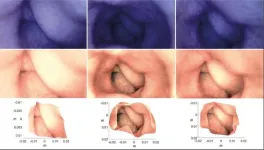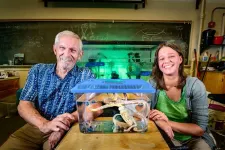Oncolytic virus senecavirus A inhibits hepatocellular carcinoma proliferation and growth by inducing cell cycle arrest and apoptosis
2024-06-25
(Press-News.org) Background and Aims
Hepatocellular carcinoma (HCC) is a highly aggressive tumor with limited treatment options and high mortality. Senecavirus A (SVA) has shown potential in selectively targeting tumors while sparing healthy tissues. This study aimed to investigate the effects of SVA on HCC cells in vitro and in vivo and to elucidate its mechanisms of action.
Methods
The cell counting kit-8 assay and colony formation assay were conducted to examine cell proliferation. Flow cytometry and nuclear staining were employed to analyze cell cycle distribution and apoptosis occurrence. A subcutaneous tumor xenograft HCC mouse model was created in vivo using HepG2 cells, and Ki67 expression in the tumor tissues was assessed. The terminal deoxynucleotidyl transferase dUTP nick end labeling assay and hematoxylin and eosin staining were employed to evaluate HCC apoptosis and the toxicity of SVA on mouse organs.
Results
In vitro, SVA effectively suppressed the growth of tumor cells by inducing apoptosis and cell cycle arrest. However, it did not have a notable effect on normal hepatocytes (MIHA cells). In an in vivo setting, SVA effectively suppressed the growth of HCC in a mouse model. SVA treatment resulted in a significant decrease in Ki67 expression and an increase in apoptosis of tumor cells. No notable histopathological alterations were observed in the organs of mice during SVA administration.
Conclusions
The in vitro study demonstrated that SVA effectively suppressed the growth of the HCC cell line HepG2 by causing cell cycle arrest and apoptosis. Nevertheless, no analogous effects were observed in the normal liver cell line MIHA. Within a living organism, the administration of SVA effectively suppressed the growth of HCC in a mouse model placed beneath the skin by triggering apoptosis. Furthermore, we have demonstrated that intratumoral administration of SVA is not associated with any safety concerns. Collectively, the data indicate that SVA could be a promising new therapeutic approach for HCC.
Full text
https://www.xiahepublishing.com/2310-8819/JCTH-2024-00125
The study was recently published in the Journal of Clinical and Translational Hepatology.
The Journal of Clinical and Translational Hepatology (JCTH) is owned by the Second Affiliated Hospital of Chongqing Medical University and published by XIA & HE Publishing Inc. JCTH publishes high quality, peer reviewed studies in the translational and clinical human health sciences of liver diseases. JCTH has established high standards for publication of original research, which are characterized by a study’s novelty, quality, and ethical conduct in the scientific process as well as in the communication of the research findings. Each issue includes articles by leading authorities on topics in hepatology that are germane to the most current challenges in the field. Special features include reports on the latest advances in drug development and technology that are relevant to liver diseases. Regular features of JCTH also include editorials, correspondences and invited commentaries on rapidly progressing areas in hepatology. All articles published by JCTH, both solicited and unsolicited, must pass our rigorous peer review process.
Follow us on X: @xiahepublishing
Follow us on LinkedIn: Xia & He Publishing Inc.
END
ELSE PRESS RELEASES FROM THIS DATE:
2024-06-25
OAK BROOK, Ill. – The structural and functional organization of the brain as shown on MRI can predict the progression of brain atrophy in patients with early-stage, mild Parkinson’s disease, according to a study published today in Radiology, a journal of the Radiological Society of North America (RSNA).
Parkinson’s disease is a progressive disorder characterized by tremors, slowness of movement or rigidity. Symptoms worsen over time and may include cognitive impairment and sleep problems. The disease affects more than 8.5 million people worldwide, and prevalence has doubled in the past 25 years, according to the World Health Organization (WHO).
One of ...
2024-06-25
The School of Computer Science at Carnegie Mellon University has launched the CMU TechBridge Coding Bootcamp to provide access to computer science education and career opportunities for high school (or equivalent) graduates.
The bootcamp will extend the reach of CMU’s computer science education offerings beyond its traditional undergraduate and graduate programs. CMU has partnered with TalentSprint to implement the program to help aspiring professionals build the skills required for launching and ...
2024-06-25
Weill Cornell Medicine received a $1.5 million grant from the U.S. Department of Defense Prostate Cancer Research Program to develop new approaches for predicting the spread of cancer cells to the bone in men with prostate cancer, using tumor samples taken at early stages of the disease.
The American Cancer Society projects about 35,250 deaths from prostate cancer in the United States in 2024. “Metastases, especially to the bone, is the leading cause of death in men who have prostate cancer,” said principal investigator Dr. Mohamed Omar, assistant professor of research in pathology and laboratory medicine, division ...
2024-06-25
“Our work shows that it is possible to re-create a fairly accurate three-dimensional (3D) model of the colon of some patients based on a single image taken by a capsule endoscopy camera - even if it's a low-quality image,” says Pål Anders Floor, a researcher at the Department of Computer Science at NTNU.
Goal: better images, faster diagnoses
He has been working for several years on using images from capsule endoscopy cameras to reconstruct an almost identical 3D model of the intestines. These cameras were first used more than 20 years ago, but low-quality images and image noise prevented this smart technology from ...
2024-06-25
Falls are the most common cause of injury among adults 65 and older in the United States. According to the U.S. Centers for Disease Control and Prevention, every year, more than 14 million older adults (one in four) report a fall. About 90% of head injuries among older individuals is due to ground-level falls.
Evaluating an older adult with a head injury in the emergency department (ED) requires careful assessment due to the increased risk of complications such as intracranial hemorrhage. There also is heightened concern for older patients taking anticoagulants or blood thinners who sustain ...
2024-06-25
Fertilizers manufactured from the sludgy leftovers of wastewater treatment processes can contain traces of potentially hazardous organic chemicals, according to a new study by Johns Hopkins University researchers.
The research, published today in Environmental Science & Technology journal, provides one of the most comprehensive looks at the chemical composition of so-called biosolids across the country and is the first step toward identifying common chemical contaminants that may need government regulation. The findings could ...
2024-06-25
CHAMPAIGN, Ill. — By giving artificial intelligence simple associative learning rules based on the brain circuits that allow a sea slug to forage — and augmenting it with better episodic memory, like that of an octopus — scientists have built an AI that can navigate new environments, seek rewards, map landmarks and overcome obstacles.
Reported in the journal Neurocomputing, the new approach gives AI the ability to explore and gather the information it needs to expand its spatial and temporal awareness, growing its knowledge base while learning on the job, said Ekaterina Gribkova, a postdoctoral researcher at the University of Illinois Urbana-Champaign who ...
2024-06-25
The leading hypothesis for the origin of firefly lights has been overturned by a genomic analysis. It had been posited that the bright lights emitted by many species in the Lampyridae family of beetles—better known as fireflies—first evolved as a warning signal to predators, advertising the toxicity of fireflies, and were then repurposed as a mating signal. This explanation would account for why eggs, larvae, and pupae also glow. Ying Zhen and colleagues put the conventional wisdom to the test by compiling a family tree of fireflies and tracing the evolution of the chemical compounds ...
2024-06-25
ASAP Launches Data-Sharing Tool with Unique Dataset of Human Postmortem-Derived Brain Samples
Aligning Science Across Parkinson’s (ASAP) launched a platform to make high-value data for Parkinson’s disease broadly available to researchers all over the world
The platform launches with data from a unique human postmortem-derived brain sequencing collection, including samples from four ASAP Collaborative Research Network (CRN) teams and 156 donors
The database will continue to expand, with 629 donors contributing to the final harmonized dataset; there will be a consistent cadence of new ...
2024-06-25
In 2018, Arthur Ashkin won the Nobel Prize in Physics for inventing optical tweezers: laser beams that can be used to manipulate microscopic particles. While useful for many biological applications, optical tweezers require extremely controlled, static conditions to work properly.
“Optical tweezers work by creating a light ‘hotspot’ to trap particles, like a ball falling into a hole. But if there are other objects in the vicinity, this hole is difficult to create and move around,” says Romain Fleury, head of the Laboratory of Wave Engineering in EPFL’s School ...
LAST 30 PRESS RELEASES:
[Press-News.org] Oncolytic virus senecavirus A inhibits hepatocellular carcinoma proliferation and growth by inducing cell cycle arrest and apoptosis




